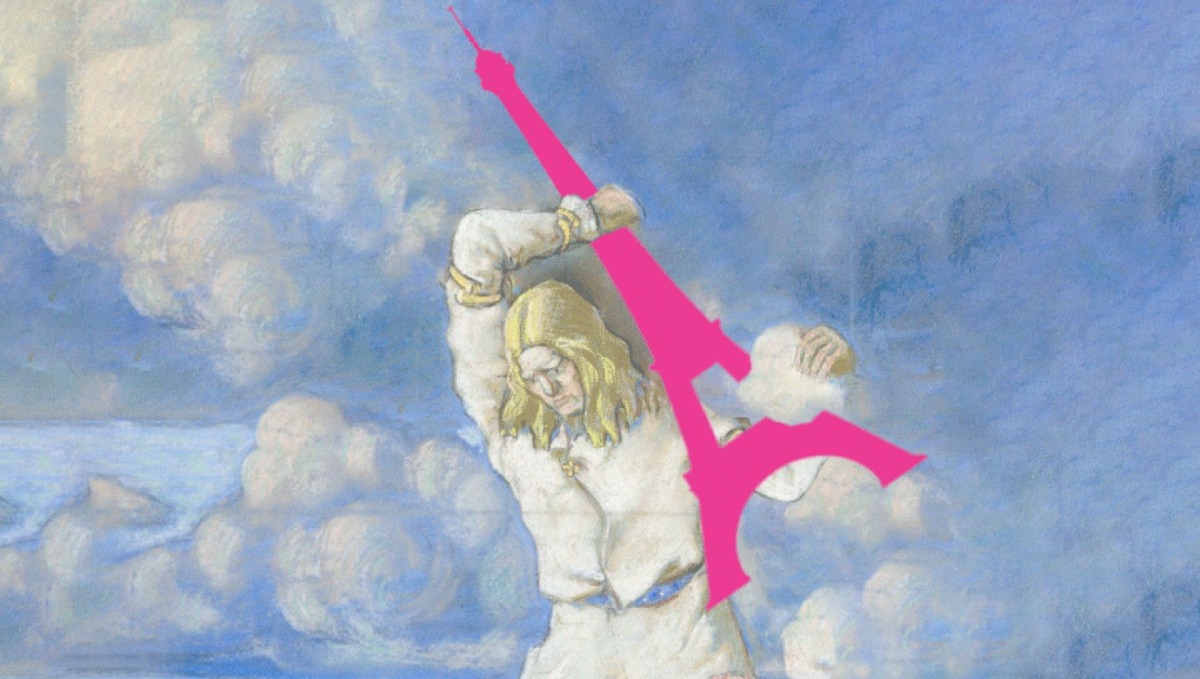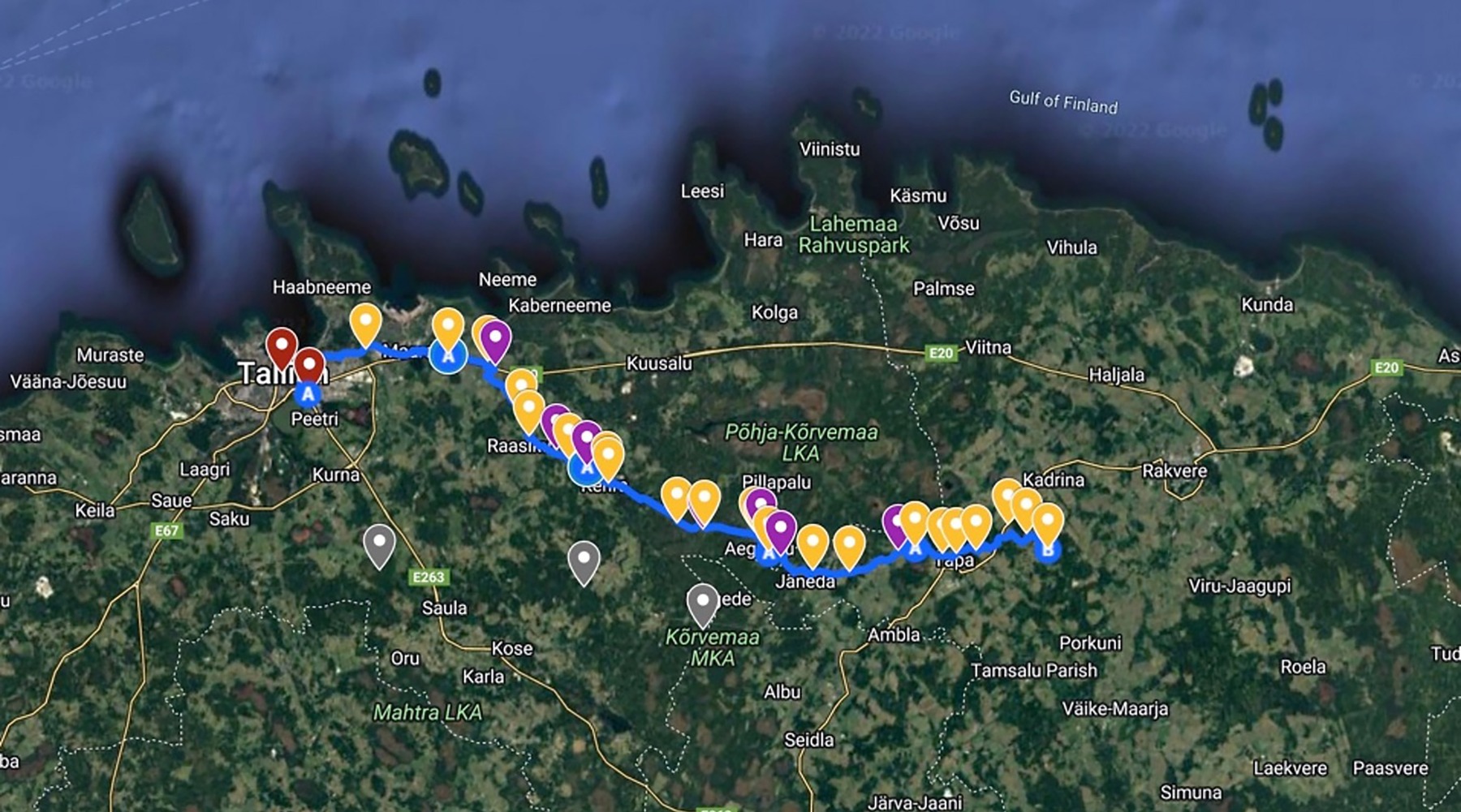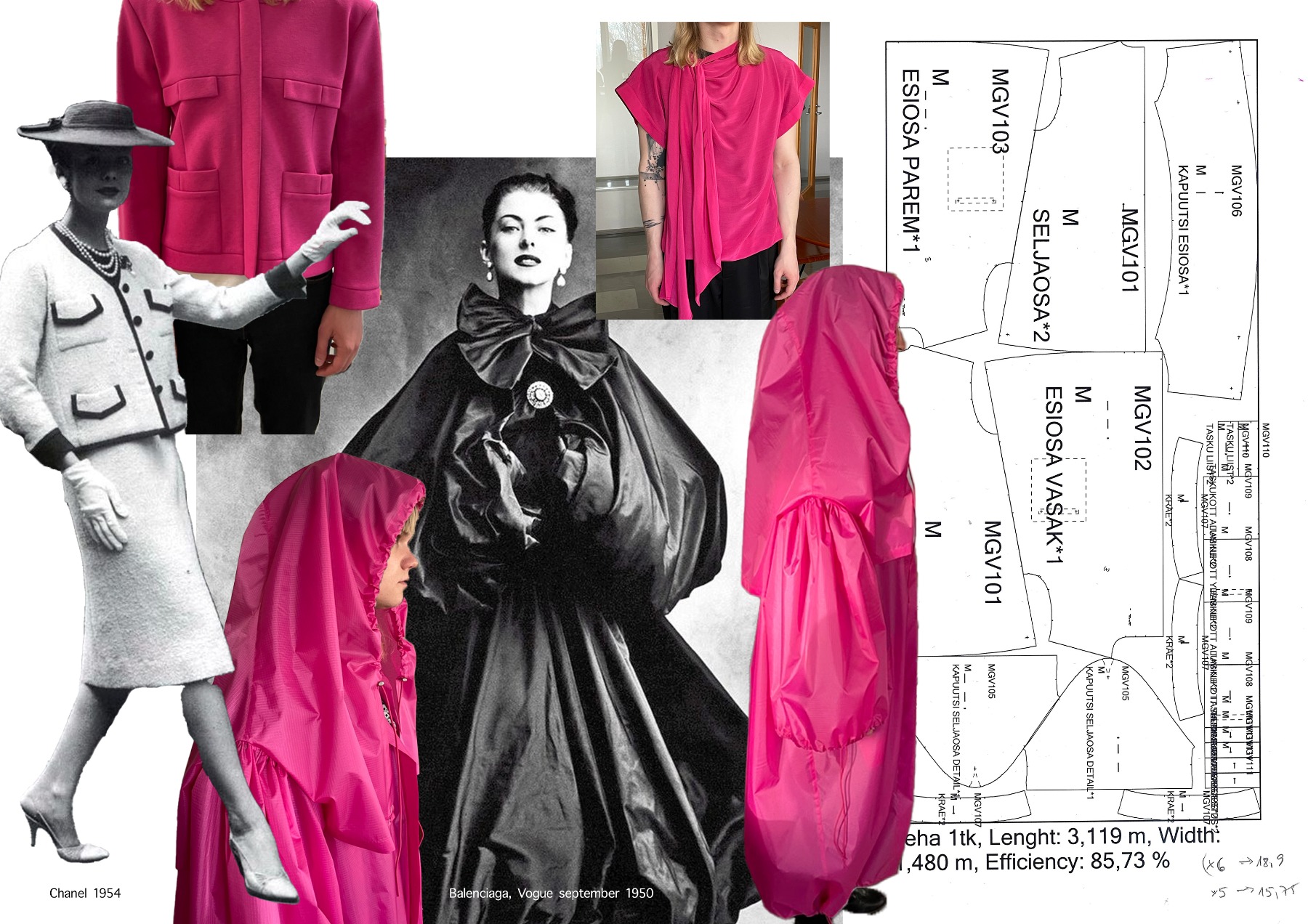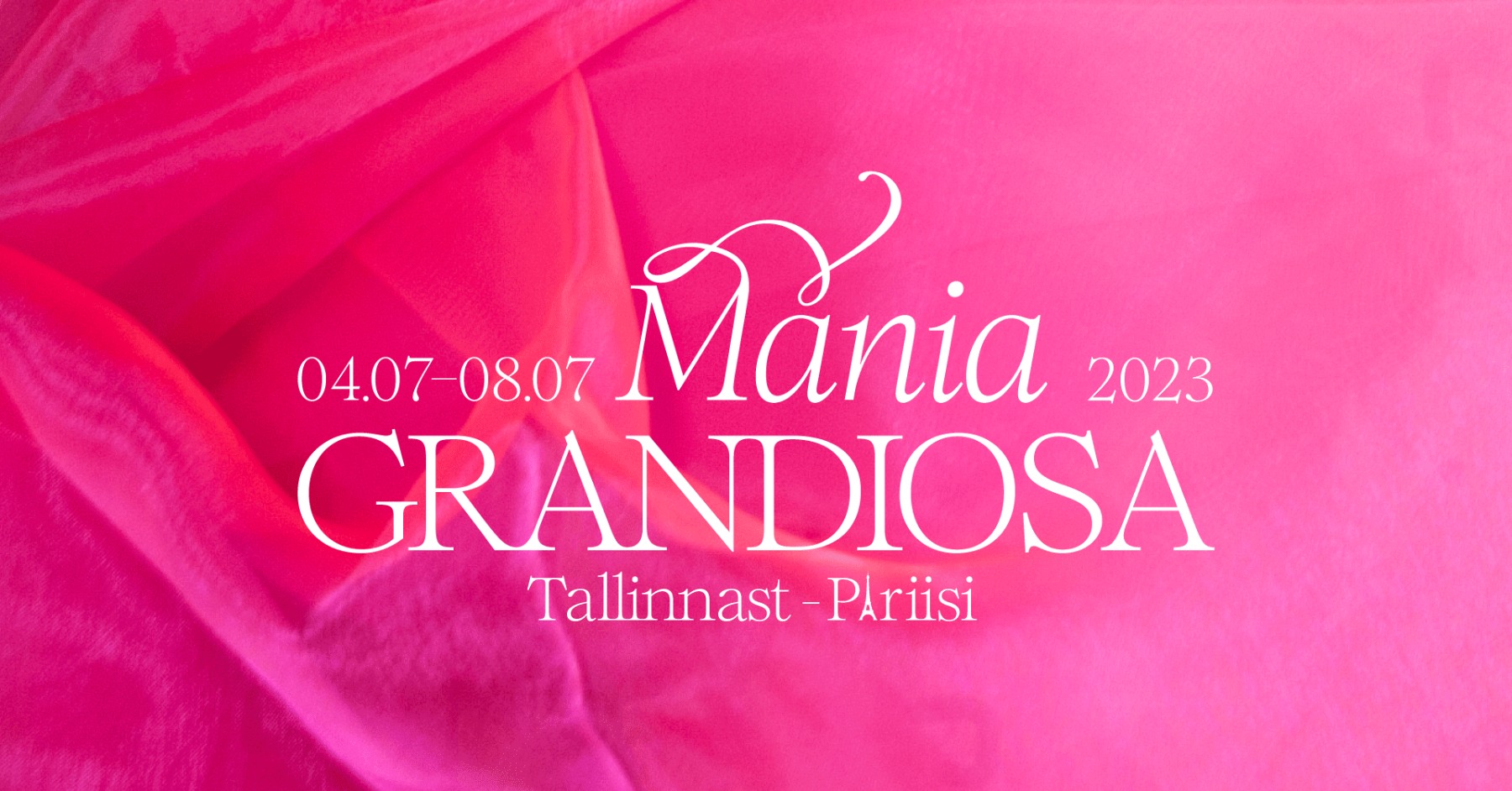
From Tallinn to Paris. The world’s longest fashion runway
The performance “MANIA GRANDIOSA. From Tallinn to Paris”
Tallinn – Pariisi, Estonia
July 4–8, 2023
Q&A with Estonian artists Karl Joonas Alamaa and Lisette Sivard
At a length of 100 kilometres and a duration of five days, the young Estonian artists Karl Joonas Alamaa and Lisette Sivard have, together with their team, created the world’s longest fashion runway. The runway will start at Tallinn Airport and end in the Estonian village of Pariisi located in northeastern Estonia. In the Estonian language, the name of this small village is equivalent to that of the metropolitan city of Paris, France. This endurance performance will be like a pilgrimage to the mecca of fashion, one which thousands of people undertake every year in the hope of finally reaching their set goal.
“MANIA GRANDIOSA. From Tallinn to Paris” is a statement on the art scene, ideals, and values of a small northeastern European country. Due to the history of the Baltics, the mentality of being suppressed and the need to work hard in order to be seen is still very present: the mindset that “determination leads to the goal”, and that the only sure way to find satisfaction and happiness is through hard work.
The fashion artists, aka the models, taking part in the show are Karl Birnbaum, Loora Kaubi, Johann Kööp, Andreas Kübar, Mirjam Mõttus, Rolands Pēterkops, Alana Proosa, Anne Vetik, and Edgar Vunš.

Could you elaborate more on the fashion artists (the models) participating in this performance? What were the principles behind their selection?
The selection of the models, aka performers, was made taking into account their background and experience. These are not only fashion artists taking part in the world’s longest runway, but more broadly, they are Estonian and Latvian creatives. They include fashion critics, designers, writers, musicians, actors, artists, and photographers. The models are with different experience levels in their own creative field – some are well-known and established artists, while others are still rising and prospective creatives. Therefore, we formulated the choice of the models in a way that all the participants are on their way to their own personal, metaphorical “Paris”. Maybe some have already arrived in “Paris”; perhaps another is halfway there, while yet another feels like they are still very far away.

How will the costumes change along the journey, and what do they symbolise?
The models will be hiking on the fictive runway for five days in a row while wearing identical ensembles designed as hiking haute couture. For example, we have a Chanel suit-inspired hiking jacket as part of the look. Along the way, the costumes will change as nature and the journey alter them. This means that the models will be wearing the exact same clothes for five days in a row in order to emphasise the beauty of the process of wearing these clothes. On a classical runway, we are used to seeing well-set, steamed, ironed, picture-perfect clothes. In contrast, clothes after the world’s longest runway will be soiled, muddy and earthy; maybe there will even be some holes in a hood or crumbs in a pocket. And yet they are still picture-perfect.
Clothes can store an experience in different ways, and the process of actively wearing the clothes is what interests us. The garments will become physical symbols of the performance, literally showing us the consequences of willpower, hope, and dreams.
How (if at all) will local communities be involved in the creation of the performance?
While the models are walking on the runway, they will pass through many small Estonian villages and places, for example, Aegviidu, Moe, Raasiku, Tapa, Kehra, etc. Some of these places have just 206 residents, while some have over 5000. Since all the models will be wearing the same magenta-coloured clothes, the sight of all-pink characters walking down your quiet street on a Wednesday morning could be quite bizarre. In cooperation with the performance’s director, Henri Hütt, we wanted to approach the journey in such a way that there would be an opportunity for integration and some kind of energy exchange. That’s why we’re giving the locals the opportunity to intervene in the models’ journey as a counterweight. Local communities have been given free license to do whatever they feel represents their hometown best in terms of showing or doing something that is important and specific to this place and through which they would like to introduce themselves. In nine places there will be a happening between the local community and the models – in the nature of intimate gestures between travellers and local inhabitants.

How will the performance be broadcast and captured? Will it be possible for audiences to watch the performance live and on-site?
Everyone who would like to walk together with the models is welcome to join them on the road. We will publish a detailed map of the journey for each day on our social media; the calendar of the happenings organised by the local communities are available on our website. It will also be possible to follow the journey of the models on our Instagram account from July 4 to 8.
The models themselves will also be documenting the journey. For example, the model-writer Andeas Kübar will also be the chronicler of the event. All five days will be captured in the written word by him. Another model, Anne Vetik, a fashion critic and journalist, will keep and publish a diary of the journey. We also have two model-photographers: Johann Kööp and Alana Proosa. As they are participating in the journey themselves, their documentary fashion photos will give a valuable and intimate insight into the whole journey. In addition, the video artist Sten Saarits will film the whole experience and formulate it into an art movie from the viewpoint of an observer.
Last but not least, the grand finale of the runway will be in the village of Pariisi on July 8, and everyone is welcome to join in. The event will be the “closing ceremony” for the longest catwalk and will consist of the first screening of the documentary of the journey, an artist talk, and performances; the night will end with live DJs and artists.
What statement does “MANIA GRANDIOSA. From Tallinn to Paris” make about the art scene and the ideals of a small northeastern European country?
Much like its neighbouring Baltic states, Estonia has experienced years of foreign occupations, and a certain sense of oppression still shapes the values of the people. The mentality of working hard is still very present: the mindset that “determination leads to a goal”, and that the only sure way to find approval, satisfaction and happiness is through hard work. On the one hand, this illustrates an inferiority complex as well as today’s capitalistic mindset; but on the other hand, it also expresses the belief that somewhere else, things are definitely better. What you already have is not good enough, and you definitely need to go far in order to become “someone”. In that sense, it works very much around the concepts of identity, self-shame, and the need for achievement.
However, it is also about a constant longing for something, which is in itself a rather broad and very human idea. Truly believing in something is actually very beautiful. Dreams and hopes are something that no one can take away from us; they offer a comforting place to escape to.
According to the artists, what role does hard work and determination play in finding satisfaction and happiness?
As the culture field is very underfunded, then quite often the only way to work is literally to work hard. As an artist, you have to be a jack of all trades. You have to produce your work, write about it, find the materials and transport them, apply to competitions and galleries, promote yourself, make posters, and also put them up. The list is endless and reaches quite absurd levels. If you want to support yourself as a creative artist, you have to put in an enormous amount of effort to find work that also makes you happy. But there is a thin line between putting a lot of effort into what you believe in and overworking yourself and burning out.
It is more about this unwavering hope that if you keep on working, you will go forward and things will get easier...even if you might already know deep inside that they will not. Maybe this hope is just an easier way to justify to yourself why you have chosen to invest yourself in something that does not have a straightforward practical value.
How does the project explore the hunger for achievement and the desire for competition in the fashion and art scenes?
The models are literally walking towards one destination – their promised land: “Paris”. It is their only wish and purpose. They know that if they walk constantly and persistently, they will arrive at a place where they want to be. They do it in the longest and hardest way possible just to make sure that they will get there. In conclusion, it is a critical/ironical take on the well-known adage of the fashion world: “If you really want it, you will get it”. But “it” is never enough and, often times, once you get what you desired, it turns out to be completely different than how you imagined it would be.
One of the core questions of our project is: What if instead of the capital of fashion and a cultural metropolis, it’s a country home that awaits us after a difficult ordeal?
Everyone wants to reach their own personal “Paris”, but if we collectively keep on praising hard-won achievements and cut-throat competitiveness, we’re only pushing each other to do more and more and even more. Someone has to break the pattern and search for alternative ways to reach this “Paris”. And we are trying to find it, together, in the village of Pariisi – in Estonia, in our homeland, and together with people we believe in.
How would you describe the mindset and spirit of today’s Estonian fashion artist generation?
It seems that it is more about collectivity. Cooperating with people who think alike. Collectiveness in the creative process can oftentimes be truly refreshing. Hopefully, it is not a temporary phenomenon, and the collectives will keep creating and doing things together. If the cultural system is underfunded and local fashion-related support networks are almost non-existent, cooperation becomes even more vital – and especially when you are at the beginning of your career.
What awaits at the destination of this fashion runway? What can this Estonian “Paris” give a fashion artist and an observer of the fashion scene, both practically and symbolically?
The destination of the fashion runway will be the small village of Pariisi in northeastern Estonia. In the Estonian language, the name “Pariisi” is equivalent to the metropolitan city of Paris. This endurance performance will be like a pilgrimage to the mecca of fashion, one which thousands of people undertake every year in the hope of finally reaching the goal they have set for themselves. We are playing with the concept of hope, therefore the models will arrive in “Paris”, but a “Paris” that is temporary – an ambivalent finish line that they will cross in order to continue moving forward.
Link for tickets: fienta.com/et/mania-grandiosa-tallinnast-pariisi




